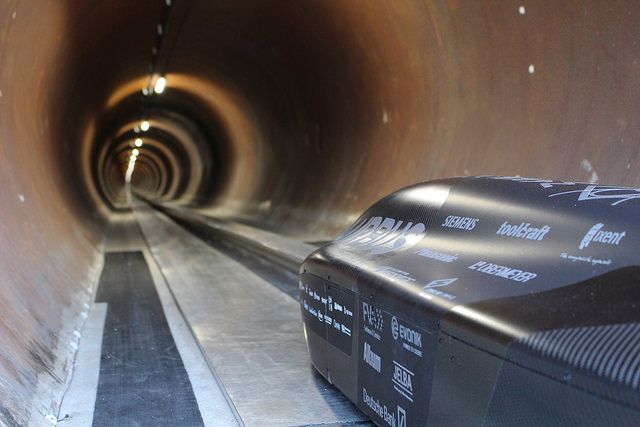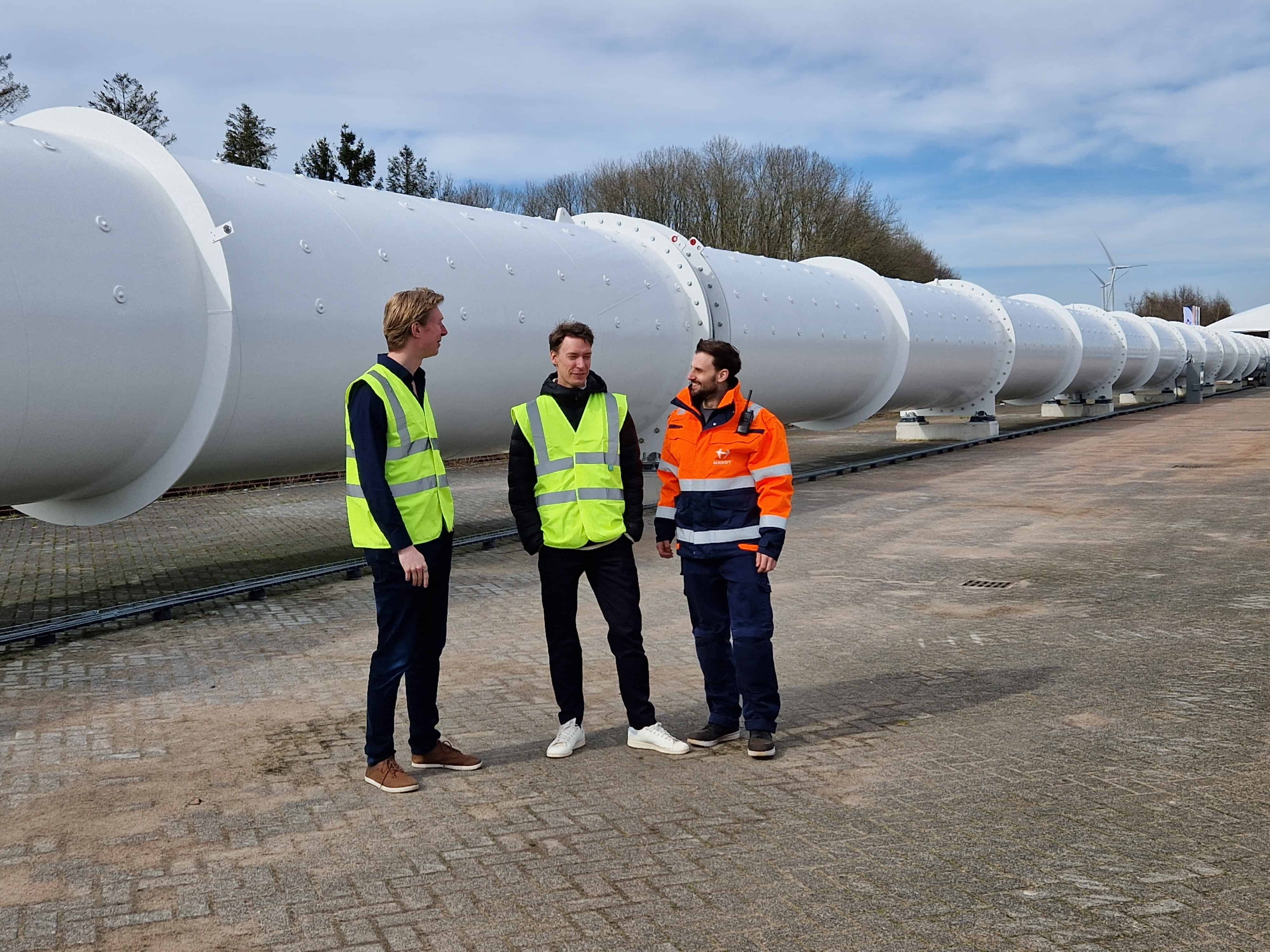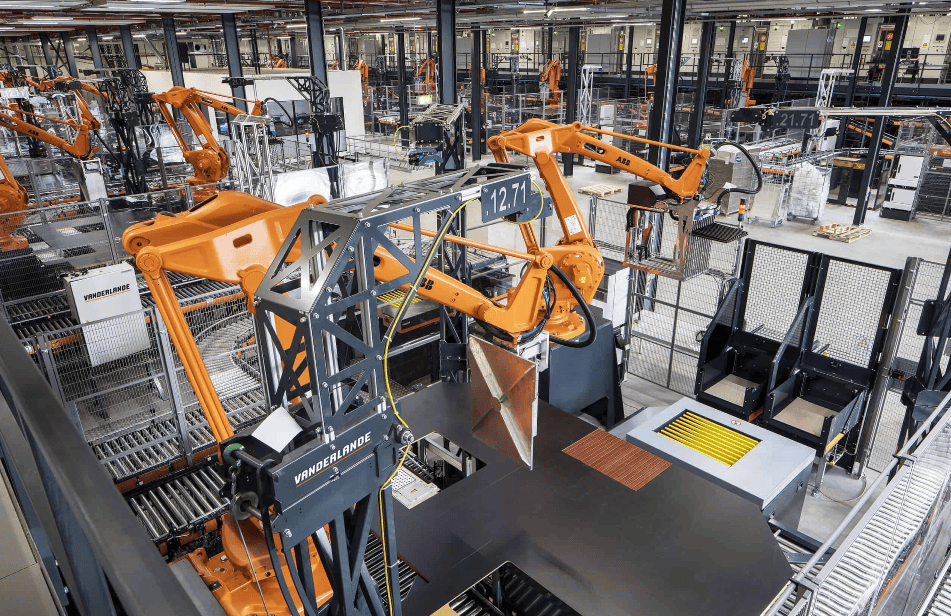
The Hyperloop concept is never going to take off, Carlo van de Weijer says. According to the head of the Strategic Area Smart Mobility at the Eindhoven University of Technology, it’s not flexible enough and it doesn’t fit into the existing transportation systems. But despite those negative expectations, Van de Weijer supports the research generated by the Hyperloop project. “All that buzz will lead to major advances in mobility. Even if Hyperloop as a serious means of transport will never happen.”
Also, read Carlo van de Weijer’s column on High-Speed Traveling
When Elon Musk first published his designs for Hyperloop, a train that could reach a top speed of 1,200 km/h, the skeptics reacted within a hypersecond. Their main concerns involved safety and cost. In the five years since, a handful of research teams have worked to make Hyperloop a reality. Initial tests were conducted in 2016 in the US, where speeds edged over 300 km/h. More trials are planned in France and the United Arab Emirates. Even so, many people still worry about the project’s safety – and even its usefulness.
Too much thrill?
Today’s travelers are accustomed to airplane acceleration, but it lasts no more than a few seconds. As the acceleration time in Musk’s concept would be significantly longer, the exposure to the G-forces for the passengers would be greater, says Alfred Rufer, professor of electrical and electronic engineering at the École Polytechnique Fédérale de Lausanne. In the 1980s and 1990s Rufer was involved in a similar project in Switzerland, Swissmetro, a magnetic levitation train that was abandoned in 2009. “If we limit acceleration to 1 meter per second squared, it would take a distance of 54 km to reach a speed of 1,200 km/h,” he explains. “Passengers would, therefore, experience acceleration lasting more than five minutes – and that wouldn’t be very comfortable.”
Then there’s the vacuum
The Hyperloop concept uses magnetic levitation to thrust capsules or pods through a steel tube maintained in a near vacuum. Traveling from Los Angeles to San Francisco – the example used by Musk when he introduced the project in 2013 – would require 600 km of tubes elevated on pylons. If the tube has a diameter of at least 2 meters, the total space stripped of air would be about 2 million cubic meters. In comparison, NASA’s Space Power Facility in Ohio, the world’s largest vacuum chamber, has a volume of 30,000 cubic meters – 66 times less.
The atmospheric pressure on the tubes under vacuum would be 10 tonnes per square meter, basically the weight of a lorry. With just the slightest crack, outside air would enter the tubes at the speed of sound, and the infrastructure would implode. “The Hyperloop would be vulnerable to terrorist attacks because it would be difficult to monitor 600 km of tubes,” says Rufer. “You’d have the same problem in the event of an earthquake. The only reasonable solution would be to go in a tunnel, where the issues of environmental impact, security and vulnerability would be solved.” Perhaps for that reason, Musk has announced that the Boring Company, his own tunnel-digging firm, plans to build a Hyperloop between New York City and Washington, D.C., underground.

How useful would it really be?
According to Carlo van de Weijer, head of the Strategic Area Smart Mobility at the Eindhoven University of Technology, the future of mobility lies in flexible systems. “The success of such companies as EasyJet, Flixbus, and Uber can be explained by how easily they fit into existing transportation systems,” he says. Instead of bringing greater flexibility to everyday transport, Hyperloop would require building all-new infrastructure. “We don’t need a transportation system that takes us only from point A to point B if it’s not integrated into existing infrastructure.”
Then there is the cost. Musk estimated that the route from San Francisco to Los Angeles would cost $6 billion. But a study by the University of Queensland puts the price tag 10 times higher. “The Japanese magnetic levitation train SCMaglev already exceeds 600 km/h. It was considerably less costly to bring into operation than potentially building the Hyperloop”, Rufer says.
But what if it could work?
Still, there are lots of intelligent people who think the Hyperloop could work after all. Elon Musk has summed up his designs in a 57-page white paper, but, busy with his other ventures, offloaded the project for others to develop. The two companies that have made the most progress are Virgin Hyperloop One and Hyperloop Transportation Technologies (TT), both operating out of the United States. A number of universities are now also pitching in to develop capsules. Given this hive of activity, should we start to believe that Hyperloop could become a reality?
Founded in 2013, Hyperloop TT is brimming with some 800 experts from NASA, Boeing, Tesla and research institutes from all over the world. From this solid basis, the company licensed a technology called InducTrack based on “passive magnetic levitation”. The system works with magnets integrated into the train pods and tracks to levitate the train. For propulsion, engineers have opted for an electromagnetic system and onboard rechargeable batteries. Powered as such, Hyperloop TT trains could reach a top speed of 1,223 km/h, says the California-based company.
Meanwhile, Virgin Hyperloop One is currently focusing on developing and testing propulsion and levitation systems. Mario Paolone, Full professor and Chair of the Distributed Electrical Systems Laboratory at the École Polytechnique Fédérale de Lausanne (EPFL), explains that the space between the capsule carrying passengers and the tracks must first be filled. “Will it be with compressed gas cushions, magnetic levitation or just pads or wheels?” he asks. “That’s the key question, along with what propulsion system they choose. In other words, will it be based on gas expansion or electromagnetic propulsion?”
Gabriele Semino, team manager of the German WARR Hyperloop team at the Technical University of Munich (TUM), says that the latest trials using current technology are leaning towards an electromagnetic model. “Elon Musk’s original Hyperloop design called for compressed air levitation,” he says. “But that can be difficult to do in a vacuum and most importantly only provides a very small levitation gap, which is in most cases not practical for longer routes. That’s why most of today’s prototypes are moving towards an electromagnetic propulsion system and magnetic levitation”. Mr. Paolone believes that a full-scale prototype, with all systems operational, could be possible before 2025.
Virgin Hyperloop One has been testing its technology in the Nevada desert since 2016.
Successful testing
In the Nevada desert, Virgin Hyperloop One has built a long tube to test the viability, resistance and speed of its revolutionary train. For now, the 8.5-metre long pod can reach a speed of 309 km/h. “We shouldn’t focus on the speed,” Mr Paolone says. “For the time being, going 1,200 km/h is technologically possible, but we need to figure out how capsules can accelerate and safely break, especially in case of contingencies, with passengers inside. A human being cannot be thrust forward, and stopped, in a tube at insane accelerations.” On top of these tests, Virgin Hyperloop One is also working on specific routes in different countries. One project is studying the feasibility of a link between Dubai and Abu Dhabi, and another envisions a connection between Mumbai and Pune, in India.
In parallel, Hyperloop TT’s futuristic train will feature 30-meter long capsules, each holding 28 to 40 passengers. The windows would be made by virtual reality companies to offer travelers interactive information or views of the landscape. The company said its system could carry 164,000 passengers a day on a single line. To test its technologies, Hyperloop TT is currently building an initial 320-meter track in Toulouse, expected to be up and running by the end of 2018. At the same time, the company will build another 1-km long test system elevated on pylons. It has also signed a deal with the Chinese group Tongren Transportation & Tourism Investment to build a 10-km long track in Tongren, in China’s Guizhou province.
Universities all in
To step up the development of functional prototypes and encourage student innovation, Virgin Hyperloop One has teamed up with SpaceX, Elon Musk’s space transportation company. The venture is sponsoring a series of competitions to drive university research. The first two competitions took place in January and August 2017, with the single objective of designing the best transport pod.
In July 2018, the third competition focused on maximum speed. Twenty teams from some 30 universities worldwide competed in the challenge. The WARR Hyperloop team from TUM took home the top prize, with a peak speed of 467 km/h. Projects from Technical University of Delft and EPFL came in with 142 km/h and 85 km/h, respectively. “This year there was no ‘pusher’ vehicle to propel the capsules,” Mr. Semino says. “So we built a pod focused on electric motors and a light carbon fiber structure. This design proved to be really good for achieving high speeds in the tube”. More on the WARR team here.
This article is a compilation from two previously published articles by The Technologist. The content was used and rearranged with permission.









